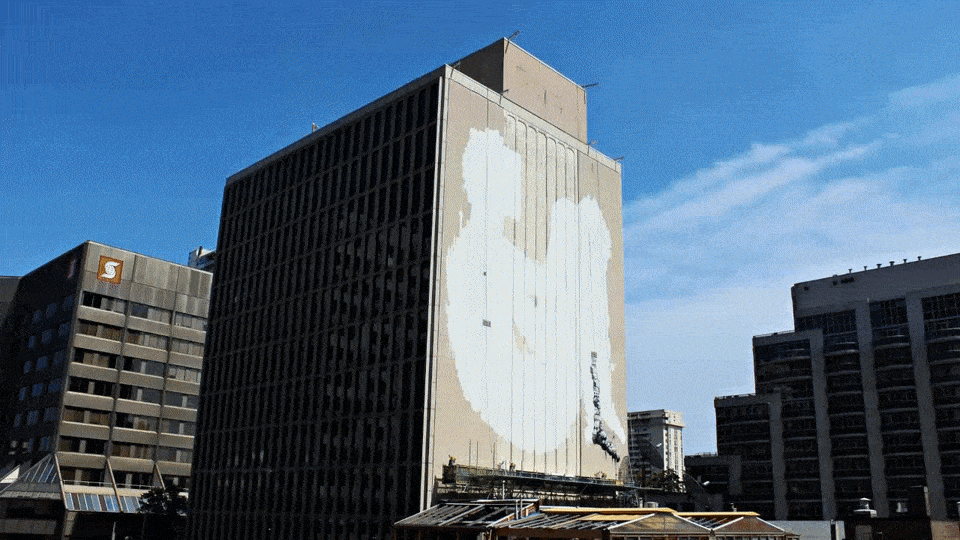How street artist Phlegm created this sublime, eight-storey mural
St. Clair’s newest piece of public art is a living, breathing portrait of Toronto

Toronto is a city of murals. There’s the Seussian façade of Lee’s Palace by Runt, the clever Gooderham building covering by Derek Michael Besant, the ever-changing exterior of the Cameron House. This week, the city added one more to the mix: an eight-storey creature by English street artist Phlegm. Here, we break down the story behind the work that now towers over St. Clair West.
The Artist
Phlegm is an anonymous illustrator based in Sheffield, an English steel town (think: Britain’s Hamilton), who earned an international following with his quirkily creepy comics. They feature strange long-limbed creatures, fantastical beasts and intricately detailed tin men who hunch over antiquated gadgets like telescopes and operate Wright Brothers–era aircraft. Eventually, he translated those characters into large-scale murals that he brings to life on city walls and in abandoned spaces in the U.K., U.S., Australia, Sri Lanka and more than a dozen other countries.

The Backstory
Slate Asset Management, the company that owns all four corners of Yonge and St. Clair, recently asked two local public-art programs, StART and STEPS, to help them beautify the intersection. The organizations couldn’t help but dream of letting an artist loose on the blank canvas that was the windowless western wall of the 12-storey Padulo building at 1 St. Clair Ave. W. STEPS wooed Phlegm, choosing him because of his experience with massive murals and his distinctive black-and-white style.

The Mural
The image itself is Phlegm’s creation, but it wasn’t designed in isolation. He proposed the idea of creating a human body out of iconic Toronto landmarks—the CN Tower, old city hall, St. Lawrence Market, the ROM—to represent the city as a vibrant, living ecosystem. Then, after consultations with local residents, he also integrated their suggestions, such as ravines and certain buildings. (For example, Scallywags, the bar directly underneath the mural, shows up in the piece.)
The Assistant
Before Phlegm began painting the mural, STEPS connected him with an assistant, the Saskatchewan-bred, Danforth-based muralist Stephanie Bellefleur. A former musician, she’d honed her artistic chops doodling in sketchbooks on her hour-and-a-half streetcar rides to and from her home in Etobicoke, and was selected for the gig from a pool of more than 100 applicants.

The Process
Every day, just after 8 a.m., Phlegm and Bellefleur met on the rooftop patio of Scallywags, where they loaded their equipment and paint onto a series of swing stages that could ascend the side of the building. The pair put in two three-hour sessions per day. Phlegm burned through about 10 spray paint cans daily, accenting the work with black and white latex paints, while Bellefleur provided logistical help: managing materials and safety equipment, operating the swing stage and offering artistic input when needed.
The Hurdles
The most difficult part was grappling with strong winds—which caused the stage to sway, occasionally making it impossible to paint—and brutal heat (Bellefleur recalls Phlegm once thinking he’d spilt paint on himself, only to realize it was all sweat.) They also had to put up with a family of raccoons that colonized the stage every night—an unfamiliar sight for a British artist. “For the first few days, Phlegm was like, ‘Oh, raccoons!’ He was so excited,” Bellefleur says. “But once they started pooping everywhere, he was like, ‘I’ve had enough. Go away.’”

The Response
The community consultation continued, albeit unofficially, throughout the three-week painting process. People living and working in nearby buildings sent Phlegm and Bellefleur tweets and messages, suggesting other buildings and images to work into the mural. A few passersby opted for a more low-tech approach, shouting at the artists from the street. When a group of kids from a nearby tennis club yelled up at them (“It looks great!”), Phlegm waved back. “It reminds you, this is what it’s meant for,” Bellefleur says. “It’s for the community.”






